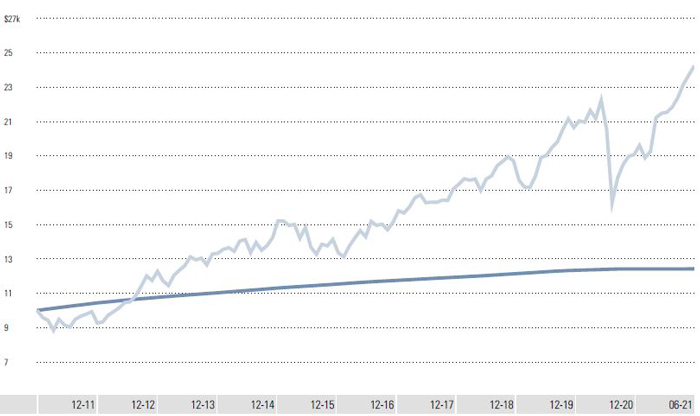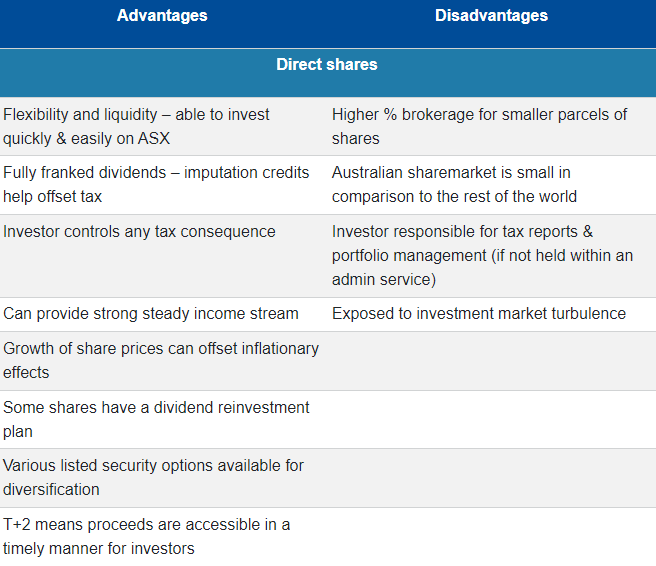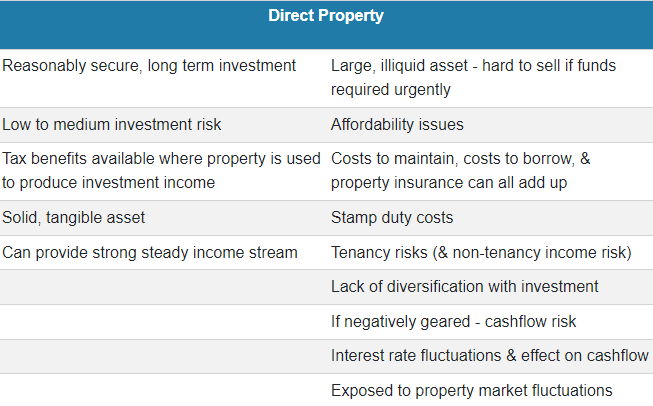Shares vs Property
Many investors swear by share investing. Many investors prefer investing in direct property. What is best for you? The answer depends on your personal investment needs and objectives and, importantly, which strategy you are comfortable with.
The following overview of both strategies may help you make a more informed decision when it comes to investing.
Investing in shares
Why are shares so popular?
- Shares have historically outperformed all other assets classes over the long term.
- Shares can provide long-term capital growth.
- Shares can provide a strong and growing income stream.
- Available tax benefits by investing in companies that pay franked dividends.
What are the challenges?
One of the more obvious challenges when investing in any sharemarket is volatility.
From the 'Black Monday' crash in 1987 to interest rates rising to around 18% in the late 80’s and early 90’s through to the general market decline in 1994, onto the 1997 Asian crisis and then the tech and internet stock boom and bust in 2000. Of course, we will never forget the 'GFC', or Global Financial Crisis, in 2008 and now, most recently, the significant fall and subsequent rise of markets through 2020 due to COVID-19.
Shares are often considered risky due to potential short-term performance volatility. Over the long term, however, shares have provided consistent investment returns.
Chart 1: Australian Shares (S&P/ASX200) vs Cash (Bloomberg AusBond Bank Bill Rate): 2011 to 2021

The Australian sharemarket is dominated by large institutions e.g. the banks, CSL and BHP. The financial sector makes up approx. 45% of the S&P/ASX200 Index. The performance of this sector, therefore, can influence the direction of the market.
Individuals invest in direct shares because they offer the possibility that their price will rise over time. Owning a share with a rising value provides growth from that investment - and an obvious benefit of capital growth is that it can offset the effects of inflation. In addition to rising share prices, dividends and dividend re-investment plans can multiply the capital growth effect of a share investment.
Note: Important disclosures can be found in the Disclosure Appendix
Tax benefits via imputation credits
The 'Dividend Yield' is the theoretical return from dividends if shares are purchased at a prevailing price. The dividend is shown as a percentage of the last sale price and is usually referred to as yield.
Many dividends paid to shareholders include 'imputation credits'. The imputation credit system was introduced in 1987 as a solution to the problem of company profits being taxed twice: once at the company tax rate, and again when a shareholder received a dividend, which was then taxed at their marginal income tax rate.
When shareholders receive dividends from companies' after-tax profits, they are entitled to an imputation credit (also known as the franking credit), which means they pay less tax on their dividend income. Indeed, if the investor's imputation credits are greater than the amount of tax payable, any surplus imputation credit is refunded to the investor (see below). Investors generally need to hold shares for at least 45 days to qualify for imputation credits.
Most companies listed on the Australian Stock Exchange that pay dividends to shareholders include imputation credits. In fact, the percentage of dividends franked by S&P/ASX 200 stocks has increased steadily from around 80% in 2008 to 85% in 2016.
The imputation credit and resulting tax benefit available from the dividends means the actual return from that particular stock needs to be "grossed up" to reflect its true value. A common mistake investors make is comparing bank rates with dividend yields. The cash rate is fully assessable whereas the dividend yield includes the imputation credits, so you need to take this tax concession into account. For example, a 2.5% fully franked dividend yield is actually providing a grossed-up return of approximately 3.6% when you take into account the added tax benefit.
Table 2 highlights the grossed-up effect of various dividend yields, as well as the equivalent after tax yield based on flat 15% (super), 32.5% and 45% tax rates.
Table 2: Grossed-up effect of yield

Surplus Franking Credits
Where there is a surplus of franking credits due to the fact the individual or entity's tax rate is lower than the 30% company tax rate, the surplus credits are refunded to that individual or entity. For example, the maximum tax rate within superannuation is 15%. Fully franked shares within a self managed super fund (SMSF), therefore, provide a 15% tax credit. This credit can be used to offset tax on other income within the fund.
If the SMSF is in pension phase, where the tax rate is 0%, franking credits are fully refunded back to the fund. This has the effect of 'topping up' the pension's account balance. Over time this can add substantial value to the fund.
Easy access
One of the key advantages of investing in direct shares, of course, is the flexibility and liquidity it provides. The Australian Stock Exchange (ASX) provides an environment for Australian investors to easily purchase or sell shares, or rebalance portfolios, in a timely and cost-effective manner. Shares can be sold in parcels or as a total portfolio with relative ease.
Investing in direct property
Property is generally viewed as a long-term investment. It can play a valuable role in an investor's overall wealth creation strategy as it can provide added diversification to balance a sharemarket portfolio and help boost overall wealth.
There are three main ways a property can create wealth:
- Capital: the value of the property increases
- Income: generated from rental returns
- Tax: deductions available which can be offset against assessable income
It can be said that the popularity of property investing has much to do with human nature, as we are inadvertently drawn to what we apparently know and understand.
The benefits of property
- Property can be a fairly secure, long-term investment.
- It is a solid, tangible asset that is considered low to medium risk (in contrast to shares which can be considered 'high risk').
- It can 'pay itself off' when the rent covers the loan repayments (except if the investment is negatively geared).
- It can provide significant tax benefits via depreciation and deductions on the costs and general upkeep of the property, if the property is being used to produce income.
What are the challenges?
Like every investment, owning property entails expenses and risks.
- There may be significant purchase costs, including legal costs, stamp duty, property inspection fees.
- Generally, most people need to borrow additional funds to purchase a property so add loan establishment fees and interest rate risk on to the above point.
- There may be significant holding costs, including maintenance, rates, body corporate fees and property insurance.
- The rental return may not meet income expectations (there is a direct relationship between the value of a property and its rental income).
- Vacancy issues. Mortgage payments still need to be met which could result in a drain on cashflow.
- Bad tenants who may incur substantial damage to the property, refuse to pay rent or even refuse to leave. Disputes can take months to resolve in some cases.
- Liquidity issues. It can take time to sell depending on the asking price and the state of the property market. This may cause further problems particularly if the seller needs fast access to funds.
- Lack of diversification by having funds tied up in one asset.
- Property location can be an important factor.
- Property markets can be turbulent. Like shares, property prices can fluctuate. Unlike shares, property prices cannot be monitored on a daily basis.
Borrowing to invest
As mentioned, most property investors borrow to purchase an investment property. There are three basic strategies to consider if you are going to borrow.
- Negative gearing: where cost of borrowing is greater than income received
- Neutral gearing: where cost of borrowing is equally offset by income received
- Positive gearing: where total income is greater than the cost of borrowing so that a cashflow surplus is generated
There is a common misconception that negative gearing is always the best strategy for property investing. The popularity of negative gearing a property it can be argued has more to do with the comfort of owning property as an investment rather than it being the best investment strategy.
It is important to bear in mind negative gearing means the investor must have adequate revenue from other sources to service the difference between investment income and outgoing costs. This can place a significant strain on cash reserves over the long term and actually backfire if a disciplined budgetary approach is not taken.
However, rental market conditions and interest rates offered, particularly in relation to residential property, may limit the choice of strategy available to the investor. If investing in commercial property, which generally offers higher rental returns, then a positively geared strategy may prove more feasible.
Practical issues
For borrowing to be appropriate, the following general conditions are recommended:
- The investor should have sufficient income to meet the expenses arising from the investment, including loan repayments, maintenance fees, insurance etc.
- The investor generally needs to own other assets which can be offered as security for the loan.
- The investment should have the potential for income and capital growth.
- Commonly, investment loans are interest-only to obtain the maximum tax advantage, however, principal & interest repayments may be required (SMSFs owning property are now required to make P&I repayments, for example).
- Accept that the strategy provides maximum return over a longer time period.
- Recognise that borrowing increases both potential return and risk.
- Borrowing to invest produces a specific obligation to service a debt. One of the critical elements of this type of strategy is to ensure continuity of income. Income protection insurance should be maintained by the investor in this regard.
Risks associated with borrowing
- Investment income risk: if investment income is lower than expected or does not grow as expected, the negative cashflow will be larger than expected and continue for longer. Negative cash flow needs to be covered by income from other sources (usually salary).
- Risk of capital loss: if the capital value reduces and the investment is sold, the proceeds may not cover the loan. The remaining loan balance will need to be repaid from other assets.
- Interest rate risk: interest rates on the loan may rise, increasing the negative cash flow needing to be covered from other sources. This risk can be managed by using fixed rate loans if applicable.
- Income risk: normal living costs still need to be met as well as the negative cashflow. What contingency plans does the investor have if salary is reduced overtime, or income ceases because of redundancy, sickness or injury, or death of the investor or their partner? Income and living costs can change following the ending of a relationship, separation or divorce.
Many of the risks arising from a reduction in income should be fully covered by insurance. Insurance should cover death, permanent and temporary disablement and most importantly, income protection. Insurance should not only cover the investor but also the partner, if applicable, as a significant change in the partner's circumstances can also significantly affect surplus cash flow available to cover negatively geared investments.


Everyone will have their own opinion as to which investment strategy is best. For many Australians, property ownership is a rite of passage. However, shares can never be overlooked as a convenient, tax effective long-term solution to generate income and wealth.
For investors approaching retirement, holding an overweight position in direct property may not be the best strategy given investment needs change in retirement.










